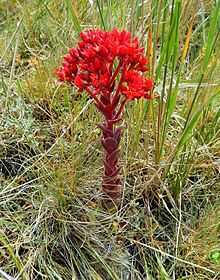| Rosularia | |
|---|---|

| |
| Rosularia flowers | |
| Scientific classification | |
| Kingdom: | Plantae |
| Clade: | Tracheophytes |
| Clade: | Angiosperms |
| Clade: | Eudicots |
| Order: | Saxifragales |
| Family: | Crassulaceae |
| Subfamily: | Sempervivoideae |
| Tribe: | Sedeae |
| Genus: | Rosularia (DC) Stapf |
| Species | |
|
See text | |
| Synonyms | |
|
Sempervivella Stapf | |

Rosularia is a small genus of the family Crassulaceae. It includes about 28-35 species from Europe, the Himalayas, and northern Africa.
Taxonomy
Rosularia was originally described by De Candolle (1828) as a section of the genus Umbilicus, and raised to the level of genus by Stapf (1923) Thus the genus bears the botanical authority (DC) Stapf of both authors.
In 1930 Berger included it in family Crassulaceae subfamily Sedoideae, as one of 9 genera. He further divided it into two sections (Eu-Rosularia and Ornithogalopsis) and further series, transferring some species of Sedum to it. Since then a number of species have been transferred in and out of the genus, including S. sempervivoides, which at one stage was placed in Prometheum. The genus Sempervivella was submerged in Rosularia. The genus is now placed within the Leucosedum clade, tribe Sedeae, subfamily Sempervivoideae of the Crassulaceae, but is embedded within Sedum paraphyletically.
Species
Rosularia contains about 28 species. The following species and subspecies were accepted by The Plant List (2013):
- Rosularia adenotricha (Wall. ex Edgew.) C.-A. Jansson
- Rosularia adenotricha subsp. viguieri (Raym.-Hamet) C.-A. Jansson
- Rosularia aizoon (Fenzl) A. Berger
- Rosularia alpestris (Kar. & Kir.) Boriss
- Rosularia alpestris subsp. marnieri(Raymond-Hamet ex H. Ohba) Eggli
- Rosularia blepharophylla Eggli
- Rosularia borissovae U.P.Pratov
- Rosularia chrysantha (Boiss. & Heldr. ex Boiss.) Takhtajan
- Rosularia cypria (Holmboe) Meikle
- Rosularia davisii Muirhead
- Rosularia elymaitica (Boiss. & Hausskn. ex Boiss.) A. Berger
- Rosularia glabra (Regel & Winkl.) A.Berger
- Rosularia globulariifolia (Fenzl) A. Berger
- Rosularia haussknechtii (Boiss. & Reut. ex Boiss.) A. Berger
- Rosularia jaccardiana (Maire & Wilczek) H. Ohba
- Rosularia libanotica (L.) Sam.
- Rosularia lineata (Boiss.) A.Berger
- Rosularia lutea Boriss.
- Rosularia pallida (Schott & Kotschy) Stapf
- Rosularia pallidiflora (Holmboe) Meikle
- Rosularia persica (Boiss.) A. Berger
- Rosularia pilosa (Fischer ex M. Bieberstein) Boriss.
- Rosularia platyphylla (Schrenk) A.Berger
- Rosularia radicosa (Boiss. & Hohen.) Eggli
- Rosularia rechingeri C.-A. Jansson
- Rosularia rosulata (Edgew.) H. Ohba
- Rosularia schischkinii Boriss.
- Rosularia sedoides (Decne.) H. Ohba
- Rosularia semiensis (J. Gay ex A. Richard) H. Ohba
- Rosularia sempervivoides (Fischer ex M. Bieberstein) Boriss.
- Rosularia serpentinica (Werderm.) Muirhead
- Rosularia serrata (L.) A.Berger
- Rosularia subspicata (Freyn) Boriss.
Distribution and habitat
Rosularia is found in arid and semi-arid regions from N. Africa (Morocco, Ethiopia), through the eastern Mediterranean to Central Asia (north of Tien Shan and east of W Himalaya), including Pakistan.
Ecology
Rosularia is an important larval host for the Central Asian butterfly Parnassius apollonius.
Uses
A number of species are cultivated as ornamental garden plants, and have been used in traditional medicine.
References
- ^ WFO 2019.
- de Candolle 1828.
- Stapf 1923.
- Berger 1930.
- ^ Sarwar & Qaiser 2012.
- ^ Ohba 1978.
- Mayuzumi & Ohba 2004.
- Thiede & Eggli 2007.
- TPL 2013.
- Tropicos 2019.
- RHS 2019.
- Tuzov 1997.
Bibliography
- Books
- Berger, A. (1930). "Crassulacaeae". In Engler, Adolf; Prantl, Karl Anton (eds.). Die Natürlichen Pflanzenfamilien. Vol. 18A. Leipzig: Verlag von Wilhelm Engelmann. pp. 352–483.
- de Candolle, A. P. (1828). "Crassulaceae". Prodromus systematis naturalis regni vegetabilis, sive, Enumeratio contracta ordinum generum specierumque plantarum huc usque cognitarium, juxta methodi naturalis, normas digesta. Vol. 3. Paris: Treuttel et Würtz. pp. 381–414.
- Tuzov, V. K. (1997). Guide to the Butterflies of Russia and Adjacent Territories: Vol. 1 Hesperiidae, Papilionidae, Pieridae, Satyridae. Coronet Books Incorporated. ISBN 978-954-642-018-3.
- Thiede, J; Eggli, U (2007). "Crassulaceae". In Kubitzki, Klaus (ed.). Berberidopsidales, Buxales, Crossosomatales, Fabales p.p., Geraniales, Gunnerales, Myrtales p.p., Proteales, Saxifragales, Vitales, Zygophyllales, Clusiaceae Alliance, Passifloraceae Alliance, Dilleniaceae, Huaceae, Picramniaceae, Sabiaceae. Springer. pp. 83–119. ISBN 978-3540322146. (full text at ResearchGate)
- Articles
- Mayuzumi, Shinzo; Ohba, Hideaki (2004). "The Phylogenetic Position of Eastern Asian Sedoideae (Crassulaceae) Inferred from Chloroplast and Nuclear DNA Sequences". Systematic Botany. 29 (3): 587–598. doi:10.1600/0363644041744329. ISSN 0363-6445. JSTOR 25063994. S2CID 84319808.
- Ohba, H (1978). "Generic and infrageneric classification of the old world sedoideae crassulaceae". Journal of the Faculty of Science University of Tokyo Section III Botany 12(4): 139-193. 12 (4): 139–193.
- Sarwar, Ghulam Rasool; Qaiser, Muhammad (2012). "A numerical taxonomy of the genus Rosularia (DC.) Stapf from Pakistan and Kashmir" (PDF). Pak. J. Bot. 44 (1): 349–354. S2CID 32097729. Archived from the original (PDF) on 2019-10-01.
- Stapf, Otto (1923). "Sempervivella alba". Curtis's Botanical Magazine. 149: 1–4.
- Websites
- TPL (2013). "The Plant List Version 1.1: Rosularia". Royal Botanic Gardens, Kew and Missouri Botanical Garden. Retrieved 1 October 2019.
- WFO (2019). "Rosularia (DC.) Stapf". World Flora Online. Retrieved 1 September 2019.
- "Tropicos". Missouri Botanical Garden. 2019. Retrieved 1 October 2019.
- "Rosularia adenotricha". Royal Horticultural Society. 2019. Retrieved 1 October 2019.
| Taxon identifiers | |
|---|---|
| Rosularia |
|
| Umbilicus sect. Rosularia | |
This Crassulaceae-related article is a stub. You can help Misplaced Pages by expanding it. |